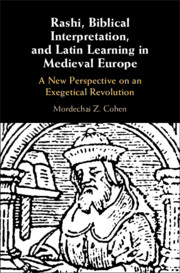 Rashi, Biblical Interpretation, and Latin Learning in Medieval Europe
Rashi, Biblical Interpretation, and Latin Learning in Medieval Europe Book contents
- Rashi, Biblical Interpretation, and Latin Learning in Medieval Europe
- Rashi, Biblical Interpretation, and Latin Learning in Medieval Europe
- Copyright page
- Dedication
- Contents
- Acknowledgments
- Abbreviations
- Introduction
- 1 A New Program of Peshat (“Plain Sense” Exegesis)
- 2 “Settling” the Words of Scripture Using Midrash
- 3 St. Bruno on Psalms: Precedent for Rashi?
- 4 Comparison to the Andalusian Exegetical School
- 5 Comparison to the Byzantine Exegetical School
- 6 Rashi’s Literary Sensibilities and Latin Grammatica
- 7 Rashi’s Notion of “the Poet” (ha-Meshorer) in the Latin Context
- 8 Joseph Qara and Rashbam: Peshat Legacy in Northern France
- 9 Literary Sensibilities of Peshat within a Latin Context
- Bibliography
- General Index
- Index of Scriptural References
- Index of Rabbinic Sources
Introduction
Published online by Cambridge University Press: 15 April 2021
- Rashi, Biblical Interpretation, and Latin Learning in Medieval Europe
- Rashi, Biblical Interpretation, and Latin Learning in Medieval Europe
- Copyright page
- Dedication
- Contents
- Acknowledgments
- Abbreviations
- Introduction
- 1 A New Program of Peshat (“Plain Sense” Exegesis)
- 2 “Settling” the Words of Scripture Using Midrash
- 3 St. Bruno on Psalms: Precedent for Rashi?
- 4 Comparison to the Andalusian Exegetical School
- 5 Comparison to the Byzantine Exegetical School
- 6 Rashi’s Literary Sensibilities and Latin Grammatica
- 7 Rashi’s Notion of “the Poet” (ha-Meshorer) in the Latin Context
- 8 Joseph Qara and Rashbam: Peshat Legacy in Northern France
- 9 Literary Sensibilities of Peshat within a Latin Context
- Bibliography
- General Index
- Index of Scriptural References
- Index of Rabbinic Sources
Summary
Rabbi Solomon Yitzhaqi (1040–1105), known as Rashi, is perhaps the most influential Jewish Bible interpreter of all time. A native of Troyes in the French county of Champagne, Rashi traveled in his youth to study for a decade in the Rhineland talmudic academies (yeshivot) of Mainz and Worms, then the intellectual center of the Ashkenazic (Franco-German) Jewish world. He returned to Troyes around 1070 and established a vibrant school of Jewish learning that ultimately drew from the best and brightest students of the Ashkenazic community, who would, in turn, become its leading rabbinic figures in the twelfth century. Rashi’s literary output centers on two major works: his Talmud commentary and his Bible commentary, each monumental in its own right. Drawing upon his training in the Rhineland academies by the disciples of the renowned Rabbenu (“our rabbi/master”) Gershom ben Judah (c. 960–1028), known as the “luminary of the diaspora,” Rashi composed a line-by-line commentary on virtually the entire Talmud, the central rabbinic work that embodies the halakhah (Jewish law). Continually perfected throughout his lifetime, Rashi’s Talmud commentary is comprised of lemmas and gloss-type notes that elucidate this highly complex and cryptic multi-volume rabbinic legal work. Though innovative in quality and style, its lineage can be traced to earlier exegetical work in the Rhineland academies, from which would emanate the Talmud commentary of “the sages of Mainz,” a collective work rooted in the teachings of Rabbenu Gershom that was in the process of formation in Rashi’s day, reaching its final form in the twelfth century.
- Type
- Chapter
- Information
- Rashi, Biblical Interpretation, and Latin Learning in Medieval EuropeA New Perspective on an Exegetical Revolution, pp. 1 - 25Publisher: Cambridge University PressPrint publication year: 2021
